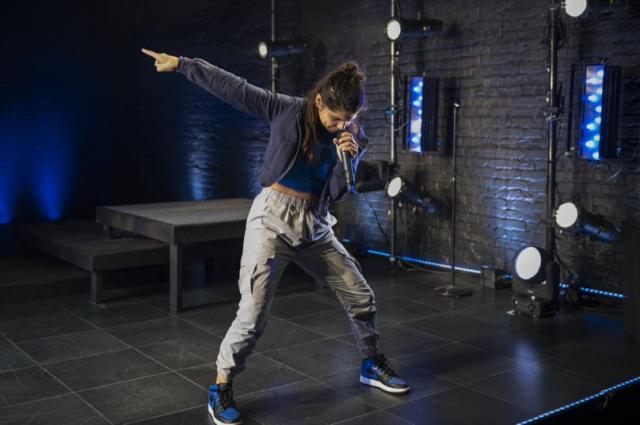

Sometimes, it’s easier to experience a show than to try and describe it to someone else. Such is the case with Milwaukee Chamber Theater’s production, Where Did We Sit On the Bus? , which is playing in a small black-box theater in Milwaukee’s Third Ward.
The intimate setting is ideal for the action that takes place onstage. It involves only two characters. One is a young Latina named Bee Quijada (Isa Arciniegas). She makes a strong case that one cannot thrive until “all parts of our identities are living in harmony.” The other “character” is actually a young musician named Kellen “Klassik” Abstron. He provides the emotional backdrop for Bee’s story, as it weaves through his intricate, original compositions. He mostly plays a synthesizer. Occasionally, Arciniegas’ character intersects momentarily with Klassik, but there’s basically no dialogue between them.
The one-woman show is part play, part concert, and part performance art. There is poetry, songs, rap and hip-hop music. The show gets its name from an early classroom lesson on Rosa Parks. Bee notes that the teacher tries to cram the entire Black experience into a single afternoon – starting with slavery and eventually getting around to Rosa Parks and the Civil Rights Movement.
When the teacher explains how Jim Crow laws worked in the American South, she notes that Rosa Parks took a stand and refused to give up her seat at the front of the bus to a white person. This sparks an interesting question. Innocently, Bee asks the teacher where HER family would sit on the bus. The flustered teacher replies that people like Bee were never on the bus at all.
This makes Bee wonder about her place in American society. “I’m not sure how I fit into this world,” she notes. “Where will I fit in?” Bee’s family immigrated to the U.S. from El Salvador. Although Bee and her youngest brother were born in the U.S., some of their older siblings came with their parents from El Salvador.
Bee’s journey of self-discovery winds through all that she has known. Her story literally begins in her mother’s womb. There’s a great deal of humor interspersed through this episode, especially as a newborn Bee comes to terms with the fact that the birthing process is a one-way interaction.
Through it all, Bee finds more delight than heartache as she encounters different aspects of her world. For instance, she lights up when talking about her first interactions with the Jewish kids at her new school. When she learns what the colors and designs mean on a classmate’s yarmulke, she responds with an enthusiastic, “awesome.” However, she also finds that her discoveries aren’t appreciated by others, particularly the other Latina girls. They taunt her about Bee’s “preference” for rubbing shoulders with “rich Jewish kids” instead of hanging out with the girls from her own neighborhood.
It takes an incredibly agile and talented performer – and musician – to make this show work. But under Brent Hazelton’s able direction, all the various sequences knit together into a whole cloth. The 95-minute play is performed without an intermission, and there’s little to distract the audience’s attention away from Bee. The simple set (by Jason Fassl) consists of little more than a series of connected platforms, which are alternately illuminated as Bee moves through her environment (Fassl is the lighting designer, too). Bee’s simple costume consists of a midriff-baring top, a small jacket and baggy pants (costumes by Jazmin Aurora Medina). Klassik’s music is supplemented by subtle environmental noises (sound design by Josh Schmidt).
The play steers clear of outright preaching on most subjects, with the exception of immigration reform. Bee plants her feet firmly on the stage and makes her argument that more migrants be allowed to enter the United States, particularly from the Mexican border.
Where Did We Sit On the Bus? is a unique blend of narrative and musical elements that is unlike anything else one might see on Milwaukee stages. It raises more questions than it answers, which is exactly the point it wants to make.
